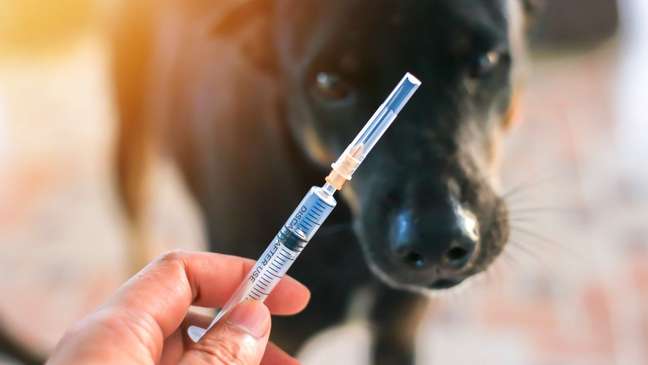On this World Rabies Day, see the importance of vaccinating your puppy against this and other diseases

September 28 is the World Anger Day, an important event for tutors’ awareness of the disease and the need to vaccinate pets to combat zoonosis. However, this isn’t the only dog disease that can be prevented with the vaccine, see? In fact, many of the major diseases affecting pets can be fought in this way.
Below we separate the main diseases in dogs that vaccines can prevent, according to Julcynete Magalhães, who is a veterinarian. Watch:
Anger
It is one of the most serious diseases for pets and has no cure yet. It is a disease – which can also be transmitted to humans – of mandatory notification. That is, the owner must notify the competent bodies in case of infection of the animal.
Rabies is transmitted through the saliva or the bite of a sick animal. After infection, the virus acts on the animal’s neurological system. Symptoms of rabies include fever, headache, excessive salivation, spasms and paralysis.
Since the rabies vaccine is the only way to avoid the disease, it is very important that tutors are vigilant and vaccinate their animals. Many cities perform vaccination efforts free to avoid this zoonosis.
Distemper
Contagious viral disease caused by the CDV virus, distemper is transmitted through direct contact with nasal and ocular secretions, coughing and sneezing. Furthermore, the feces can also contain infecting viruses.
In the first stage of the disease, the dog may have breathing problems. However, the disease can get worse and cause neurological damage with effects such as spasms, paralysis and convulsions.
Distemper can lead to death and the only way to avoid it is with immunization, which is found in most vaccines (eight or ten).
parvovirus
Parvovirus is also considered a serious viral disease. Transmission occurs through the feces of other sick animals and affects the digestive system of dogs. With vomiting and diarrheamost often with blood in the stool, the disease can cause dehydration in the animal.
Because it is a resistant virus, the infectious agent can stay indoors for months, even after cleaning. So, if the dog contracts the disease, it is necessary that the environment remains for at least six months without receiving other animals. Parvovirus can be prevented with multiple vaccines.

canine infectious hepatitis
IS dog liver infection, caused by type-1 adenovirus. The virus affects the animal’s liver cells and can be fatal.
The disease, especially common in younger animals, is transmitted through oral and nasal secretions, as well as other secretions, such as the feces of infected animals. After hitting the liver, it causes fever, vomiting, diarrhea, and eye damage.
The main way to prevent the disease is through more vaccines.
leptospirosis
It is an infectious disease transmitted by the leptospira bacterium during direct or indirect exposure of the animal to the urine of contaminated animals. Transmission is also possible through contact of mucous membranes or injured skin with contaminated water.
It is worth noting that the disease is a zoonosis, therefore it can also pass to man. Symptoms include fever, vomiting, diarrhea, loss of appetite, dark urine and mouth ulcers, as well as a yellowish color in the animal’s eyes and mouth.
Multiple vaccines are the best way to prevent disease in pets.
canine infectious respiratory diseases
Considered some kind of canine flu, is a contagious disease that affects the dog’s respiratory tract. There are several viruses and bacteria responsible for the infection, including Bordetella bronchiseptica (Bb), parainfluenza virus (CPIV), and type 2 adenovirus (CAV-2).
There are also several clinical signs of the disease, but the main ones are fever, runny nose and cough, followed by possible tachypnea and severe airway damage, which can progress to pneumonia.
Prevention against CPIV and CAV-2 is in multiple vaccines, while against Bb it is in a separate vaccine or together with the above-mentioned strains.
canine enteric coronavirus
Coronavirus is a viral disease that affects the dog’s gastrointestinal tract. The symptoms are severe diarrhea, loss of appetite, vomiting, dehydration, increased body temperature and chillsas well as apathy and depression.
The animal can become infected with the feces of sick animals. The disease is not fatal, but, together with other diseases, such as parvovirus, it can worsen the general condition of the animal and increase the mortality rate.
It is possible to prevent this highly contagious disease with vaccination, through multiple vaccines.
canine giardiasis
The disease, transmitted by the protozoan Giardia lamblia, causes the dog to have intestinal problems, such as diarrhea. Since the symptom is very similar to that of many other diseases, confirmation of the diagnosis depends on the parasitic examination of the stool.
It is a zoonosis that can mainly affect children, the elderly and immunosuppressed people by ingestion of the cysts. The animal can be contaminated by the faeces of several infected animals, by unfiltered water and by food that has not been properly sanitized. In this sense, it is possible to avoid it disease specific vaccine.
leishmaniasis
It is one of the most serious zoonoses. The transmission of canine visceral leishmaniasis occurs mainly from the bite of the phlebotomist, better known as the sand fly. Furthermore, the dog is held responsible for maintaining its life cycle in the urban environment, as it has the greatest number of parasites, mainly on the skin.
Diagnosis is considered difficult, as there are a wide variety of symptoms which, by themselves, do not confirm the disease, such as excessive nail growth, anemia, paleness of the mucous membrane, dermatitis, spleen and liver growth, among others .
There are treatments for leishmaniasis that increase the survival and quality of life of the infected animal, but there is no cure. Therefore, the main way to protect the animal is through the leishmaniasis vaccine.
Finally, it is worth mentioning that, for each of these vaccines, it is necessary to research the number of doses needed and other important information before bringing the dog to be vaccinated.
Source: Julcynete Magalhães, veterinarian and commercial supervisor of VetBR.
+The best content in your email for free. Choose your favorite Earth Newsletter. Click here!
Source: Terra
Benjamin Smith is a fashion journalist and author at Gossipify, known for his coverage of the latest fashion trends and industry insights. He writes about clothing, shoes, accessories, and runway shows, providing in-depth analysis and unique perspectives. He’s respected for his ability to spot emerging designers and trends, and for providing practical fashion advice to readers.







